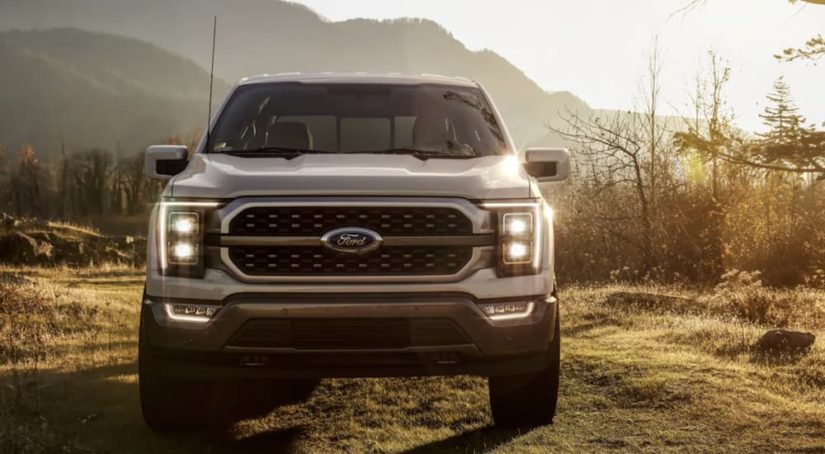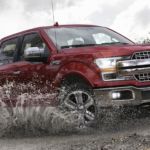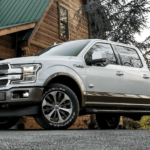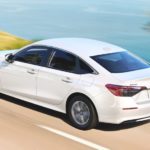Both Ford and Toyota pickups are incredibly popular, so how do you decide between them? Depending on what you’re looking for, it can be simple to make a pros and cons list, or it can get incredibly complicated. I know I tend to get stressed before making a big purchase, and I like to research and see what others have to say in case I missed something or might want to consider another option. You may also like to compare and contrast certain models to better find a model that fits your needs. This can often help to immediately see what vehicles are lacking the specific features you want, while highlighting others. If that sounds like you, not to worry—if you’ve been wanting an exciting, comprehensive exploration of the 2022 Ford F-150 vs 2022 Toyota Tundra, you’re in luck. Here are the key differences between the two vehicles:
#1: A Tale of Two Countries
It might seem obvious, but a big difference between Ford and Toyota is where they’re from—Toyota is a Japanese brand, and Ford is American, which means different design aesthetics, priorities regarding performance, and abilities.
Traditionally, Toyota is known for its somewhat angular designs, while Ford fits somewhere between straight lines and curves. Toyota also tends to make smaller vehicles, though upon entering the American market, it has had to adjust somewhat in order to compete.
Toyota’s reputation was built on the back of its practical, sensible vehicles, while Ford has always had a penchant for vehicles with double purpose—a workhorse during the day with the ability to host a tailgate party in the evening. If you’re a straightforward person, you may want to take a peek at the Tundra, but if you like having options, then the Ford F-150 might be a better fit.
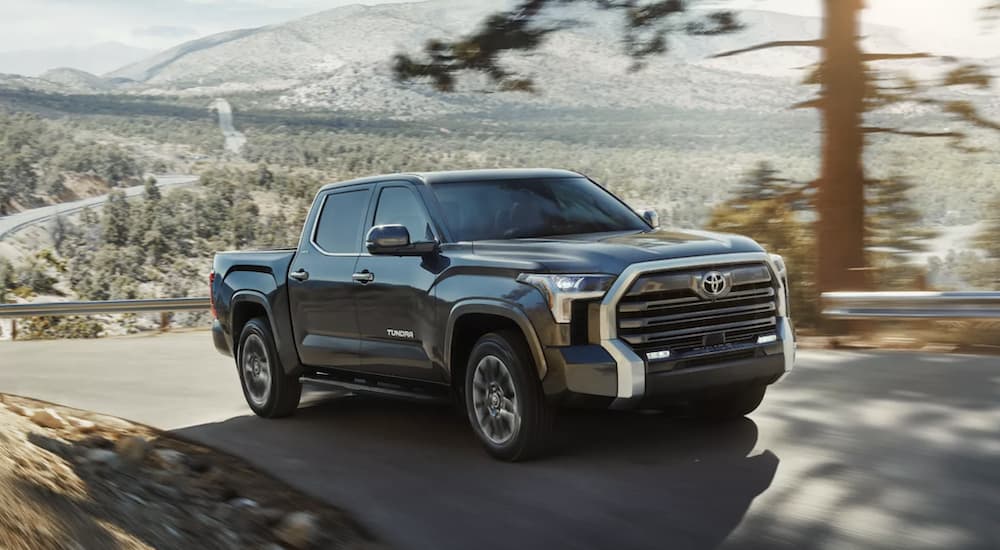
#2: Vroom, Vroom
As you might expect, there are twice as many engine options for the F-150 than the Tundra, though that might not make much of a difference depending on what you need or want in your next vehicle. The Tundra does not have a V8 option, but it does have a twin-turbo V6 in a nonhybrid or hybrid option. The F-150, on the other hand, can be driven with gas, diesel, or as a hybrid in a V6, a twin-turbocharged V6, and a V8, which means that if you’re living in a hilly or mountainous region with curvy roads, you may want to consider the F-150’s extra power over the Tundra’s more mild offering. However, if you’re intrigued by the Tundra and want to try it out, there are some things mentioned in the next section that might help turn the tide in favor of Toyota’s half-ton pickup.
#3: Trim Level Surprise
While I do expect American vehicles to have more choices as Americans tend to be individualistic and prefer to customize their cars and make them unique, this isn’t the case with these pickups—the Tundra has ten different trim levels, while the F-150 only has seven.
The F-150 is more concentrated on additional options like the Black Appearance package, cab and bed configurations, and more exterior trim, while the Tundra instead focuses on more interior particulars and specifications, like engine choice (several hybrid options available), coil-spring rear suspension, and an off-road package that equips the Tundra for more rugged adventures.
The Ford pickup is suited for a wide range of individuals, from work crews to ranch owners to city drivers, whereas the Tundra is built for a narrower audience, with less towing and payload capability, one engine option, and nicer amenities, even on the basic trim level.
#4: Multi-Tasking Vs. Single Task Machines
In America, multi-tasking is seen as productive and necessary, even though some believe it isn’t either one of those things. We still try to multi-task because of American “hustle” and “hard work” culture, which is why Ford’s F-150 can be used for a variety of things, including a mobile workspace, which is helpful for those drivers who drive for work, need a place to sleep overnight, or who might need to type something up after hours.
Yes, the F-150 comes with a convenience feature that utilizes the gear shift’s ability to fold flat in order to create a rather roomy flat workspace. Another ingredient in this multi-tasking mix is the flat-folding front chairs, which can form a bed for individuals needing to stay on the job site or who are pulling over at the rest stop for a few hours to get some shut-eye before continuing toward their destination. Should you need some extra power, there’s also an available generator for the F-150, which can crank out about 7.2-kW for power tools, a karaoke machine, or any number of smaller electronics.
If you prefer to keep your work and life separate, then you may lean more toward the Tundra, which is still spacious, with plenty of cubbies for all your items that need to be stored while on the road, but without the pressure to work and drive at the same time while planning an overnight stay in the pickup.
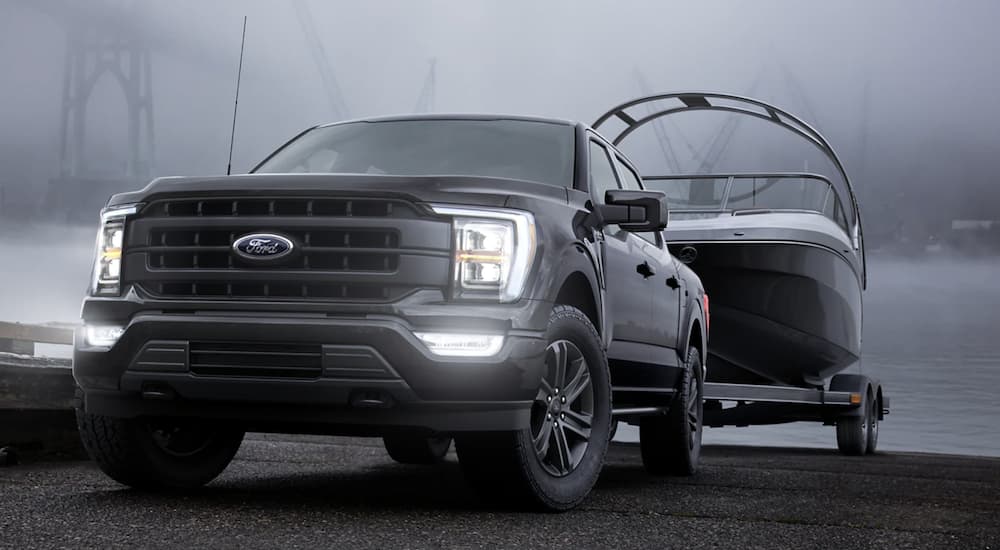
#5: Tech Features
This is yet another area where the Ford shines as a multi-option vehicle. The Tundra’s offerings are rather subtle and perhaps even overlooked, though they shouldn’t, because the Tundra has a bit more to offer in terms of technology than its half-ton, full-size counterparts. Infotainment centers have become standard in many models, and the Tundra is no exception. Though the initial infotainment screen at the basic trim level is 8”, there is an upgrade to a 14” horizontal screen if that’s preferred. Android Auto and Apple CarPlay capability are available, as well as a WiFi hotspot. That is subscription-based, which is pretty typical across the board, with few exceptions, though one of the exceptions is on this list.
Meanwhile, the Ford F-150 offers either an 8” or 12” screen, with Apple CarPlay, Android Auto, and WiFi as standard across all trim levels. If you’re looking for an upgrade, you can get Sirius XM or have a Bang & Olufsen stereo system. There are also onboard telematics for those who need a fleet of vehicles and a way to track them. There are lots of options available, perfect for every customer, whether you’re purchasing for individual or business use.
Which One Are You?
There are a wide variety of reasons why people would like either the Ford F-150 or the Toyota Tundra—depending on your personal preferences, work needs, family size, hobbies, and travel, one or the other will be a better fit for you. My Dad chose our Ford F-150 because of its versatility and size, while some of his friends chose a Toyota because they needed a work vehicle.
Over time, I’ve grown rather fond of the Toyota Tundra because of its simple yet elegant exterior and interior, as well as its less expensive maintenance and parts. However, I do believe that the F-150 worked best for our family because of all the available options. And perhaps that’s where you’re at, too—which of these makes more sense to have right now? Will your needs change over time? Even if they do, choices still need to be made. So which truck do you see yourself in?
